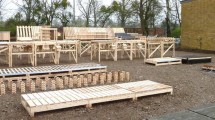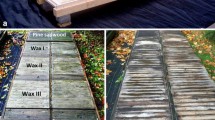Abstract
The durability of European oak (Quercus spp.) is under debate for a long time. In contrast to its classification as ‘‘durable’’ timber species according to EN 350-2 (CEN 1994), results from different comparative studies have clearly shown a lower durability, especially for in-ground exposures. To highlight this conflict more detailed, a case study on oak fence posts, which had been in service for 5, 10, 20, 30, and 60 years, was carried out. The posts were examined in terms of decay type and intensity, remaining cross section, wood moisture content, and different characteristics of the adjacent soil. The durability of the oak posts was affected by high variation. Posts prematurely failing after only five years were found as well as posts still serviceable after 60 years. Different findings of the study have the potential to increase the understanding of durability aspects in the future and might be considered for calibration and adaption of field and laboratory test methods in the future: The ground line turned out to be not the most severe exposure for posts, although it is generally assumed to be. Furthermore, no significant negative impact of remaining sapwood portions on the durability of the heartwood was found, but the important role of radial cracks for the initiation of decay became apparent. In this regard further potentially important factors for the in-ground durability are size and shape of timber components.
Zusammenfassung
Die Dauerhaftigkeit von Eichenholz (Quercus spp.) wird seit langer Zeit kontrovers diskutiert. Während es nach EN 350-2 (CEN 1994) als ,,dauerhaft‘‘ (Dauerhaftigkeitsklasse 2) eingestuft wird, haben Ergebnisse vergleichender Studien eine deutlich geringere Dauerhaftigkeit belegt, insbesondere bei Exposition mit Erdkontakt. Um diesen Widerspruch näher zu betrachten, wurde eine Fallstudie an Eichenzaunpfählen durchgeführt, die sich bereits seit 5, 10, 20, 30 und 60 Jahren im Gebrauch befanden. Die Pfähle wurden in Bezug auf Art und Intensität von Fäulnis, Restquerschnitt, Holzfeuchte und verschiedener Charakteristika des umgebenden Bodens untersucht. Die Dauerhaftigkeit der Eichenpfähle war durch eine hohe Variation gekennzeichnet. Frühausfälle nach nur fünf Jahren wurden ebenso beobachtet wie Pfähle, die nach 60 Jahren immer noch gebrauchstauglich waren. Verschiedene Erkenntnisse aus der Studie tragen zu einem besseren Verständnis der Dauerhaftigkeit von Eichenholz im Erdkontakt bei und ließen sich zur Kalibrierung und Anpassung von Labor- und Freiland-Prüfmethoden berücksichtigen. So stellte sich die als besonders kritisch erachtete Boden-Luft-Zone nicht als die Zone mit der stärksten Befallsintensität heraus. Weiterhin ließ sich kein signifikanter negativer Einfluss von Splintholzanteilen auf die Gebrauchsdauer der Pfähle nachweisen; die besondere Rolle radialer Risse in den Pfählen als Ausgangspunkt für Fäulnis wurde hingegen deutlich. In diesem Zusammenhang sei ebenfalls auf die Bedeutung von Dimensionierung und Form von Bauteilen auf die Dauerhaftigkeit im Erdkontakt hingewiesen.
Similar content being viewed by others
References
Van Acker J, Stevens M, Carey J, Sierra-Alvarez R, Militz H, Le Bayon I, Kleist G, Peek R-D (2003) Biological durability of wood in relation to end-use. Part 1. Towards a European standard for laboratory testing of the biological durability of wood. Holz Roh- Werkst 61:35–45
Aloui F, Ayadi N, Charrier F, Charrier B (2004) Durability of European oak (Quercus petraea and Quercus robur) against white rot fungi (Coriolus versicolor): relations with phenol extractives. Holz Roh- Werkst 62:286–290
Augusta U (2007) Untersuchung der natürlichen Dauerhaftigkeit wirtschaftlich bedeutender Holzarten bei verschiedener Beanspruchung im Außenbereich. Dissertation, University of Hamburg
Ayadi N, Charrier B, Irmouli M, Charpentier JP, Jay Allemand C, Feuillat F, Keller R (2001) Interspecific variability of European oak durability against white rot fungi (Coriolus versicolor): Comparison between sessile oak and peduncle oak (Quercus petraea and Quercus robur). Document No. IRG/WP 01-10393. International Research Group On Wood Protection, Stockholm, Sweden
Brischke C, Welzbacher CR, Rapp AO, Augusta U, Brandt K (2009) Comparative studies on the in-ground and above-ground durability of European oak heartwood (Quercus petraea Liebl. and Quercus robur L.). Eur J Wood Prod 67:329–338
CEN (1990) EN 252 Wood preservatives – Field test method for determining the relative protective effectiveness of a wood preservative in ground contact. CEN (European committee for standardization), Brussels
CEN (1994) EN 350-2 Durability of wood and wood-based products – Natural durability of solid wood – Part 2: Guide to natural durability and treatability of selected wood species of importance in Europe. CEN (European committee for standardization), Brussels
CEN (2005) CEN/TS 15083-2 Durability of wood and wood-based products – Determination of the natural durability of solid wood against wood-destroying fungi, test methods – Part 2: Soft rotting micro-fungi. CEN (European committee for standardization), Brussels
Clausen CA, Ross RJ, Forsman JW, Balachowski JD (2001) Condition assessment of roof trusses of Quincy Mine Blacksmith shop in Keweenaw National Historical Park. Research note FPL-RN-0281, United States Department of Agriculture, Forest Products Laboratory
De Groot RC, Feist WC, Eslyn WE, Gjovik LR (1979) Protecting wood fences for yard and garden. Publication Serial No. A 3052, Cooperative Extension Programs, University of Wisconsion, USA
DIN (1977) DIN 52183 Prüfung von Holz. Bestimmung des Feuchtigkeitsgehaltes. Deutsches Institut für Normung, Berlin
Guilley E, Charpentier JP, Ayadi N, Snakkers G, Nepveu G, Charrier B (2004) Decay resistance against Coriolus versicolor in Sessile oak (Quercus petraea Liebl.): analysis of the between-tree variability and correlations with extractives, tree growth and other basic wood properties. Wood Sci Technol 38:539–554
Haneca K, Van Acker J, Beeckman H (2005) Growth trends reveal the forest structure during Roman and Medieval times in Western Europe: a comparison between archaeological and actual oak ring series (Quercus robur and Quercus petraea). Ann For Sci 62:797–805
Helsing GG, Graham RD (1976) Saw kerfs reduce checking and prevent internal decay in pressure-treated Douglas-fir poles. Holzforschung 30:184–186
Humar M, Fabčič B, Zupančič M, Pohleven F, Oven P (2008) Influence of xylem growth ring width and wood density on durability of oak heartwood. Int Bio Bio 62:368–371
ISO (2005) ISO 10390 Soil quality – Determination of pH. International Organization for Standardization, Geneva
ISO (2000) ISO 11268-2 Soil quality – Effects of pollutants on earthworms (Eisenia Fetida) – Part 2: Determination of effects on reproduction. International Organization for Standardization, Geneva
Kollert W (1991) Die Eiche im Holzaufkommen und Außenhandel. Forstwiss Cent-bl 110:196–206
Leicester RH, Wang C-H, Nguyen MN, Foliente GC (2005) Engineering models for biological attack of timber. TT4-217. Proceedings of the 10th Conference on Durability of Building Materials and Components, Lyon, France
Levy JF (1987) The natural history of the degradation of wood. Phil Trans R Soc Lond A 321:423–433
Morrell JJ (1990) Effect of kerfing on performance of Douglas-fir utility poles in the Pacific Northwest. Document No. IRG/WP/3604. International Research Group On Wood Protection, Stockholm, Sweden
Schepers J (1994) Haus und Hof westfälischer Bauern. Aschendorffsche Verlagsbuchhandlung, Münster
Sell J (1980) Oberflächenbehandlung von Brettschichtholzträgern: Anforderungen: Anforderungen, praktische Erfahrungen und Versuchsergebnisse. Holz-Zentralblatt 106:629–630
Author information
Authors and Affiliations
Corresponding author
Rights and permissions
About this article
Cite this article
Brischke, C., Rolf-Kiel, H. Durability of European oak (Quercus spp.) in ground contact – A case study on fence posts in service . Eur. J. Wood Prod. 68, 129–137 (2010). https://doi.org/10.1007/s00107-009-0364-7
Received:
Published:
Issue Date:
DOI: https://doi.org/10.1007/s00107-009-0364-7




